The oceans of the world are home to an estimated 20,000 species of saltwater fish. Each one has a unique appearance, from your average sea bass to the striking appearance of a stoplight parrotfish. Continue reading to learn about the 17 most colorful saltwater fish, including where you may find them in the world!
1. Flame Angelfish
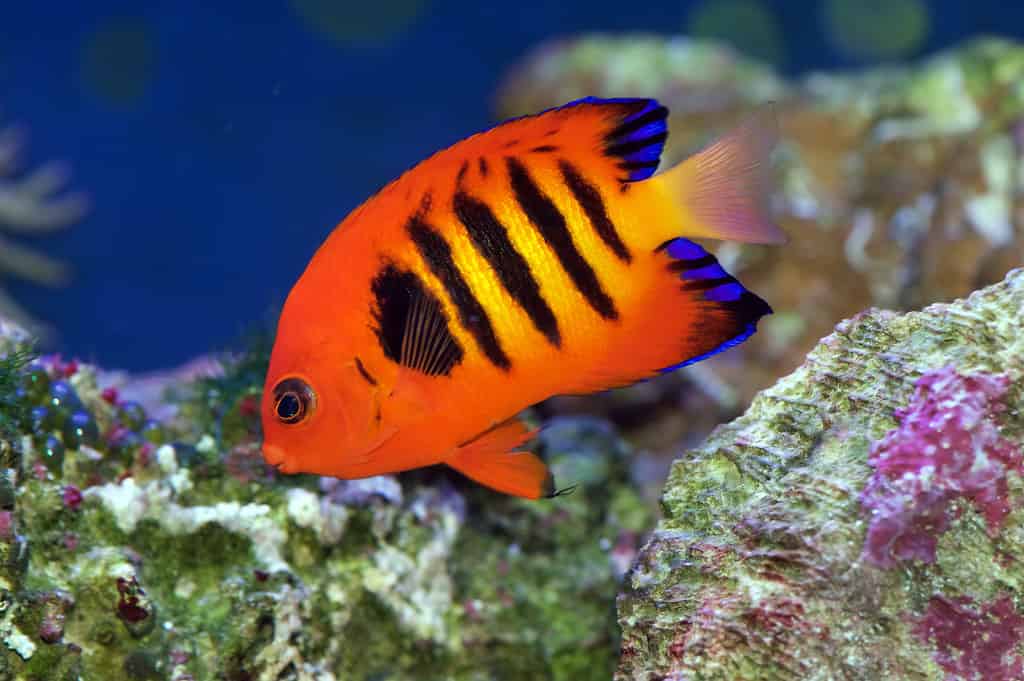
Flame angelfish gained their name from their fiery appearance.
©PAUL ATKINSON/Shutterstock.com
The flame angelfish (Centropyge loricula) has several other names that you may be more familiar with, such as the flame angel, flaming angelfish, or Japanese pygmy angelfish. They are named for their bright orange bodies. These feature several vertical black bars. The tail fins sport violet-blue edgings. Males of this species are larger than their female counterparts, as well as more colorful.
Flame angelfish are native to the tropical regions of the Pacific Ocean. Most commonly, they can be found around the reefs of Australia and the surrounding islands. Flame angelfish may also be found around the Hawaiian Islands, although this is a less common occurrence.
These colorful saltwater fish can live in aquariums and tanks.
2. Queen Angelfish

The queen angelfish lives at the bottom of the ocean floor.
©Daryl Duda/Shutterstock.com
Another member of the family Pomacanthidae, the queen angelfish (Holacanthus ciliaris) is located in the western Atlantic Ocean. This species is also known as the blue angelfish, golden angelfish, and yellow angelfish.
One of the most interesting facts about the queen angelfish is that it is a benthic species. This means that it lives on the ocean floor. This species, in particular, is a benthic species that lives in the warm waters of coral reefs.
The scales of this species are a blue-green color with yellow tips. Their fins are bright yellow, with orange tips and blue bases in some areas. Queen angelfish also sport brightly colored markings. They have a cobalt blue crown above their eyes, which also serves to tell them apart from other closely related species. As juveniles, they sport brightly colored blue vertical stripes. These fade in adulthood.
3. Mandarin Dragonet

Mandarin dragonets have a beautiful orange-scrawled design.
©Makabas/Shutterstock.com
The Mandarin dragonet (Synchiropus splendidus) is a popular saltwater aquarium fish. Their brightly colored bodies can light up a tank. However, outside of captivity, the Mandarin dragonet is native to the warm waters of the Pacific Ocean. This includes the waters surrounding the Japanese Ryukyu Islands south to those surrounding Australia. Their specific name, splendidus, comes from the Latin for “glittering” and “bright”—a proper name for this example of one of the most colorful saltwater fish.
This fish is one of few vertebrates that sport a natural bright blue coloring. Their blue bodies are adorned with a swirling orange pattern, and their faces sport a greenish hue. Research has unveiled that the Mandarin dragonet has a slime coat that may protect from disease and deter predators. As a result, it is hypothesized that they are aposematic. This means that their bright colors act as a warning, much like the coloration of a poison dart frog.
4. Emperor Angelfish
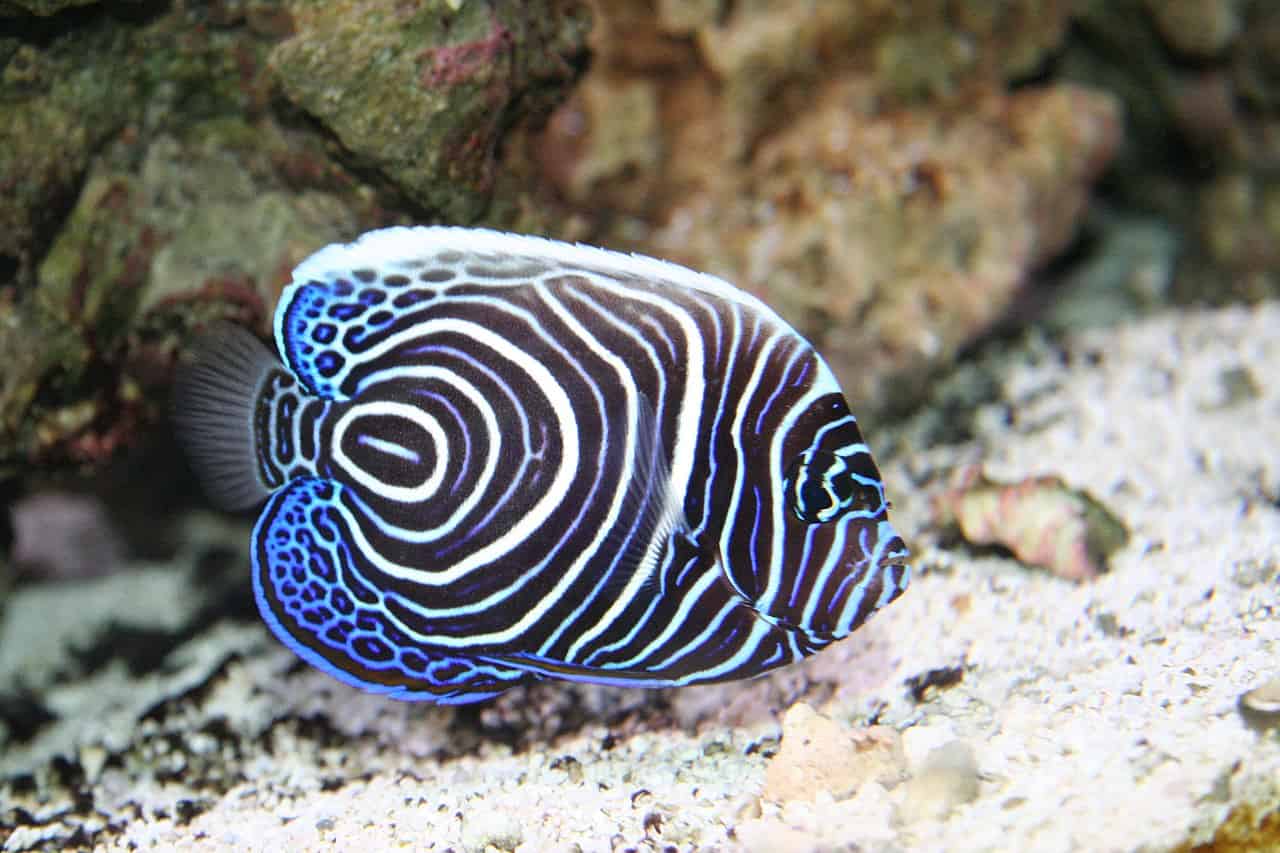
Juvenile emperor angelfish have an eye-catching curbed pattern that fades into yellow and blue stripes as adults.
©Vic Brincat (cadmanof50s) from Keswick, Ontario, Canada, CC BY 2.0, via Wikimedia Commons – License
The emperor angelfish (Pomacanthus imperator) is another reef fish. However, this species is native to both the Indian Ocean and the Pacific Ocean. Its range extends from the Red Sea to Hawaii. This picturesque fish is popular for both its juvenile and adult colorations.
As a juvenile, the emperor angelfish sports a dark blue body with concentric curving lines. These lines alternate between blue and white, creating an eye-catching pattern. The adults have a much different, but equally stunning, coloration. Adults have pale blue faces, with a dark blue mask around the eyes. Their bodies have yellow and blue stripes. The bottom of their bodies, near the pelvic and anal fins, is dark blue. In contrast, the dorsal region is a striking bright yellow color.
They are a rather large reef fish species, reaching a maximum length of around 16 inches.
5. Bicolor Dottyback
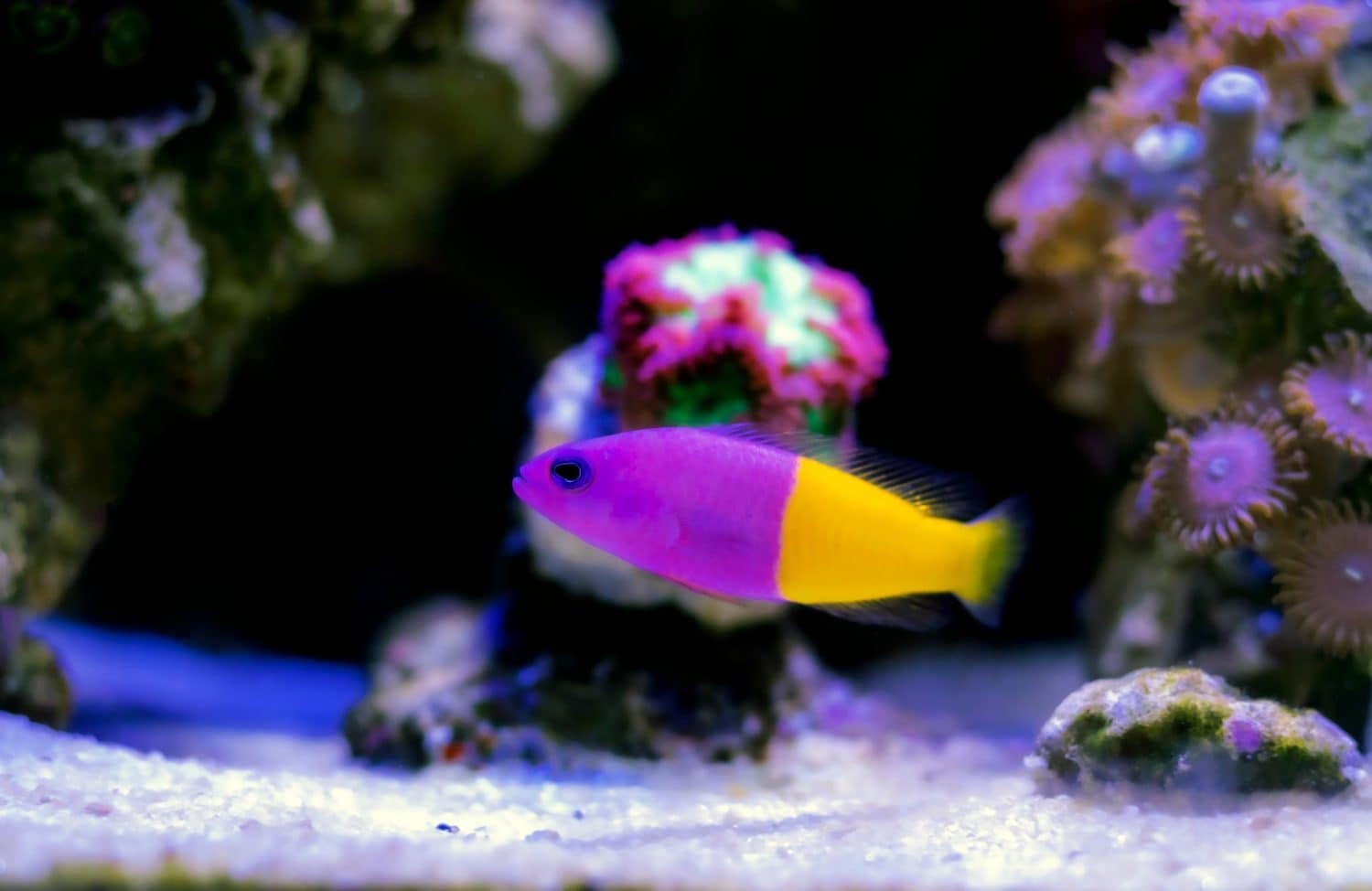
Royal dottybacks are also known as royal dottybacks and other names.
©Vojce/Shutterstock.com
The royal dottyback (Pictichromis paccagnellorum) is a common addition to many marine aquariums. This is thanks to their unique coloring, with a bright purple face and bright yellow posterior end. You may also know this species as the royal dottyback, Gramma Dotty, and false gramma. Like the emperor angelfish, most bicolor dottybacks are native to the Indo-Pacific Ocean.
6. Stoplight Parrotfish
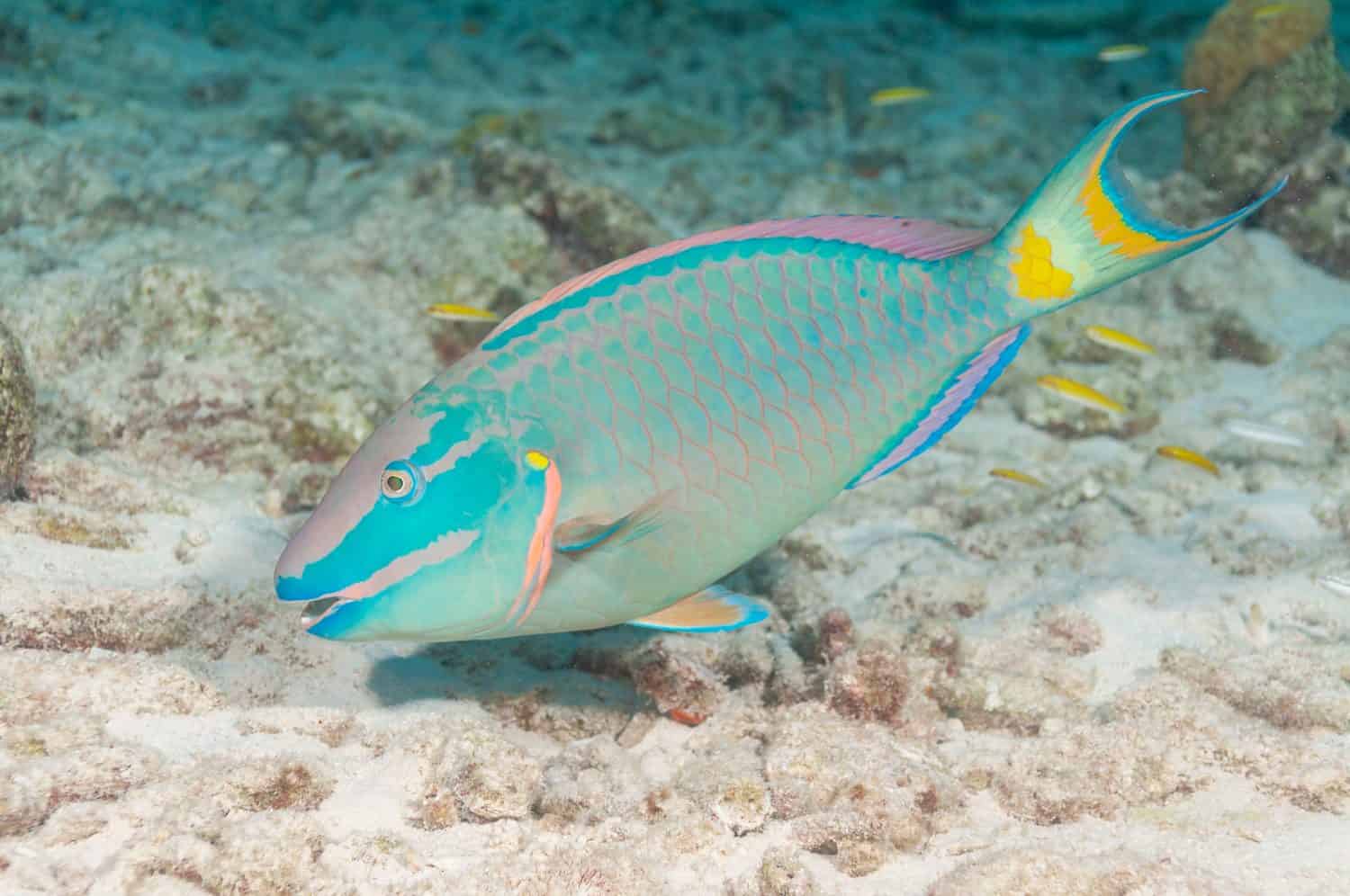
The stoplight parrotfish is one of the most colorful saltwater fish in the world, having shades of blue, red, green, and yellow.
©Jesus Cobaleda/Shutterstock.com
Although most species of parrotfish boast beautiful colorations, the scales of the stoplight parrotfish (Sparisoma viride) are especially striking. They received their name for the striking yellow patch that appears on the tail during the terminal phase.
The stoplight parrotfish is a protogynous hermaphrodite, which means that it changes from female to male during its life. The terminal phase is the final stage in which they are male. During the two previous phases, juvenile and initial, the stoplight parrotfish has a reddish-brown coloration. The stomach is a vivid red. During the terminal phase, they develop a bright blue-green coloration with yellow markings as well as red tips to some scales.
Stoplight parrotfish inhabit the coral reefs in the warmer waters of the Atlantic, such as off the coast of Florida, the Caribbean Sea, and the Gulf of Mexico. They can, however, inhabit waters far south as Brazil.
7. Hogfish
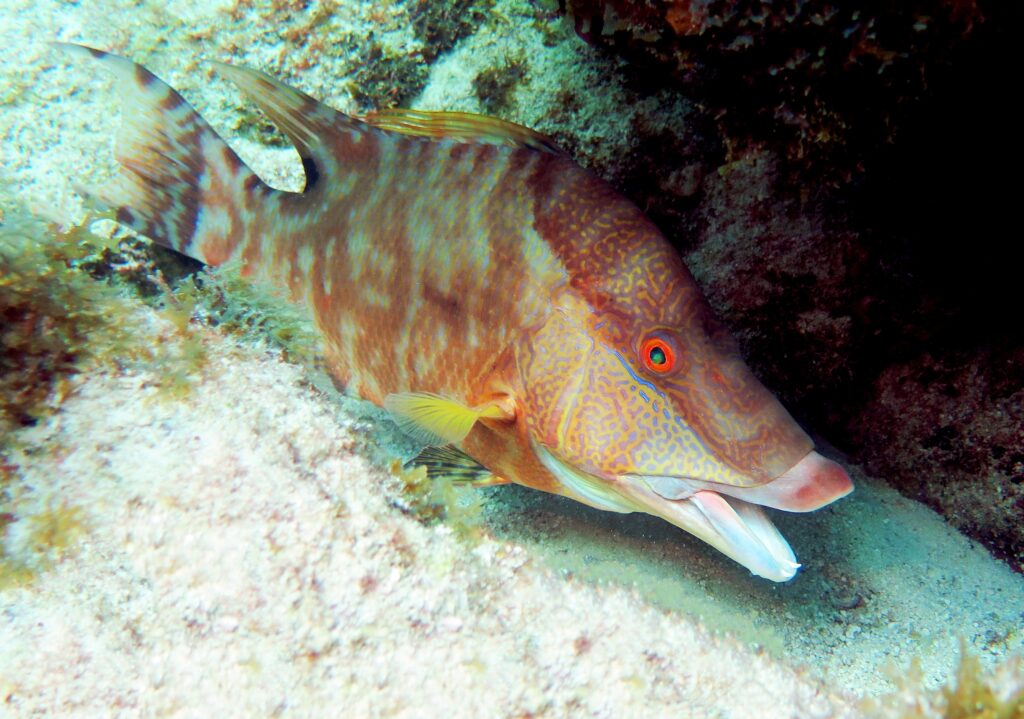
Hogfish have bright red eyes!
©Daryl Duda/Shutterstock.com
The hogfish (Lachnolaimus maximus) goes by many other names. This includes doncella de pluma, boquinete, and pez perro—all of which are more common ways to refer to this fish in Mexico. These interesting fish are native to the Western Atlantic Ocean, with a range extending from Nova Scotia to northern South America. This includes the Gulf of Mexico, where they are in abundance. The only member of their genus, hogfish, are carnivorous fish common near coral reefs.
The name “hogfish” comes from the fish’s pig-like snout, which they use to root through the ocean floor in search of crustaceans. They have a dark red coloration, with males sporting dark banding on the face and yellow fins. Some individuals sport large dorsal spines. Their coloration allows them to easily camouflage and blend into their environments, especially coral reefs. This can aid in hunting since they prefer to search for food near these reefs.
8. Scrawled Cowfish
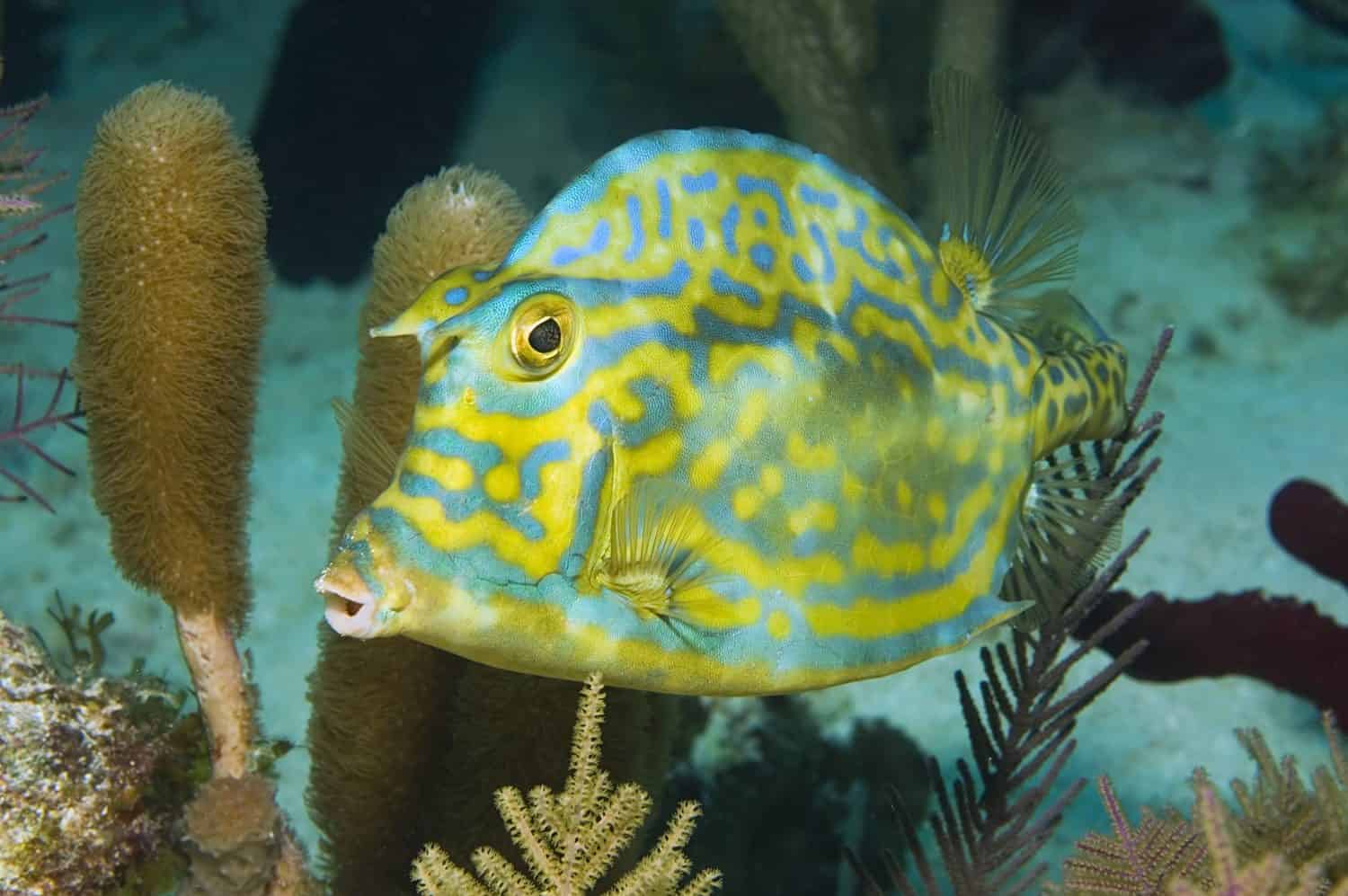
Scrawled cowfish can be found in shallow waters.
©Durden Images/Shutterstock.com
The scrawled cowfish (Acanthostracion quadricornis) sports a unique coloration. Overall, their bodies are a beige-yellow color. However, they are named for the bright blue scrawled markings across their bodies. They also receive their name, cowfish, from the projections that grow above their eyes, resembling horns. Along with the namesake blue markings, the scrawled cowfish sports several dark blotches along their bodies.
Scrawled cowfish can be found throughout the Western Atlantic Ocean. However, their range is not as extensive as that of the hogfish. They live in the waters off the coast of Massachusetts to those near Brazil. They live in shallow water, typically among grass beds. Rather than fleeing or fighting, when disturbed, the scrawled cowfish will attempt to remain motionless, relying on their camouflage for protection.
9. Regal Blue Tang

The regal blue tang is the only member of its genus
©Henner Damke/Shutterstock.com
You may recognize this colorful saltwater fish from the movie Finding Nemo! The regal blue tang (Paracanthurus hepatus) is a popular saltwater fish, whether found in the wild or in marine aquariums. They are known by several other names, including the
- Regal tang
- Palette surgeonfish
- Blue tang
- Flagtail surgeonfish
- Royal blue tang
- Hippo tang
- Blue hippo tang
- Pacific regal blue tang
- Blue surgeonfish
The regal blue tang is native to the western and central regions of the Indian Ocean. It is important to know their scientific name, as the regal blue tang may be easily confused with the blue tang (Acanthurus coeruleus), which is found in the Atlantic Ocean. This is because the species are similar in appearance and share common names.
10. Pajama Cardinalfish
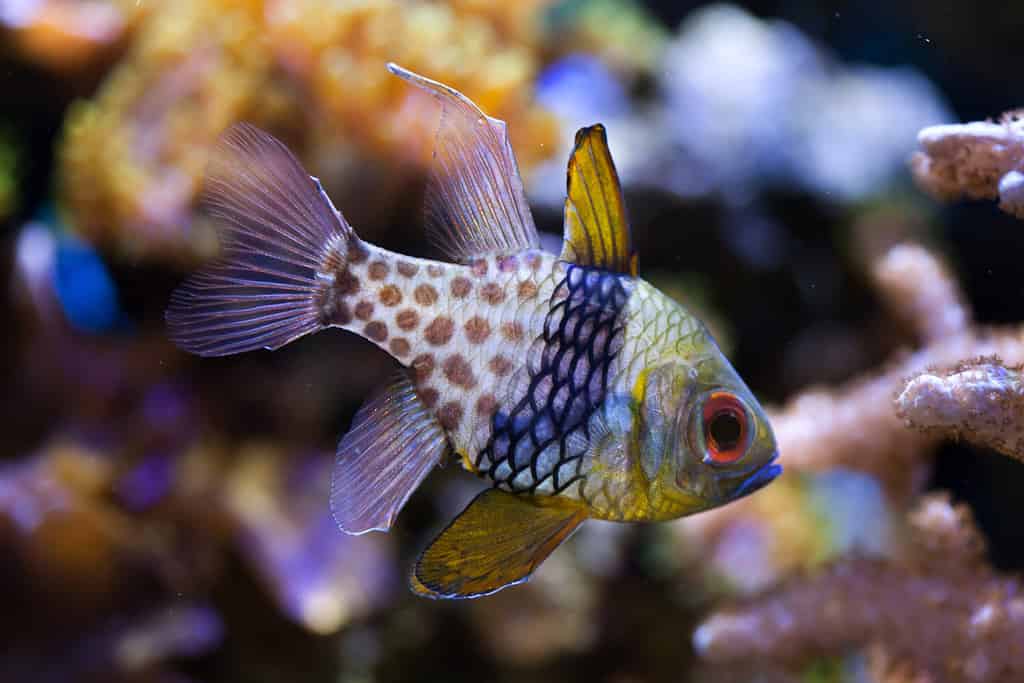
Pajama cardinalfish have a unique polka-dotted appearance.
©Vladimir Wrangel/Shutterstock.com
The pajama cardinalfish (Sphaeramia nematoptera) is a popular aquarium species that goes by many other names, including spotted cardinalfish, coral cardinalfish, and polkadot cardinalfish. They are named for their colorful, fun appearance, which features their tell-tale polka dots. Along with these orange dots, though, they have a green-yellow face and bright orange eyes.
While they may be bold in color and appearance, the pajama cardinalfish has a mild and meek personality. They easily assimilate into marine aquariums. However, they are a schooling species of fish with a social hierarchy. Although they have roles and places within their community, though, pajama cardinalfish don’t resort to violence when it comes to asserting their dominance within the ranks. This peaceful behavior is not often seen in other species of cardinal fish.
Pajama cardinalfish are native to the Western Pacific Ocean. You can find them as far south as the Great Barrier Reef.
11. Cinnamon Clownfish
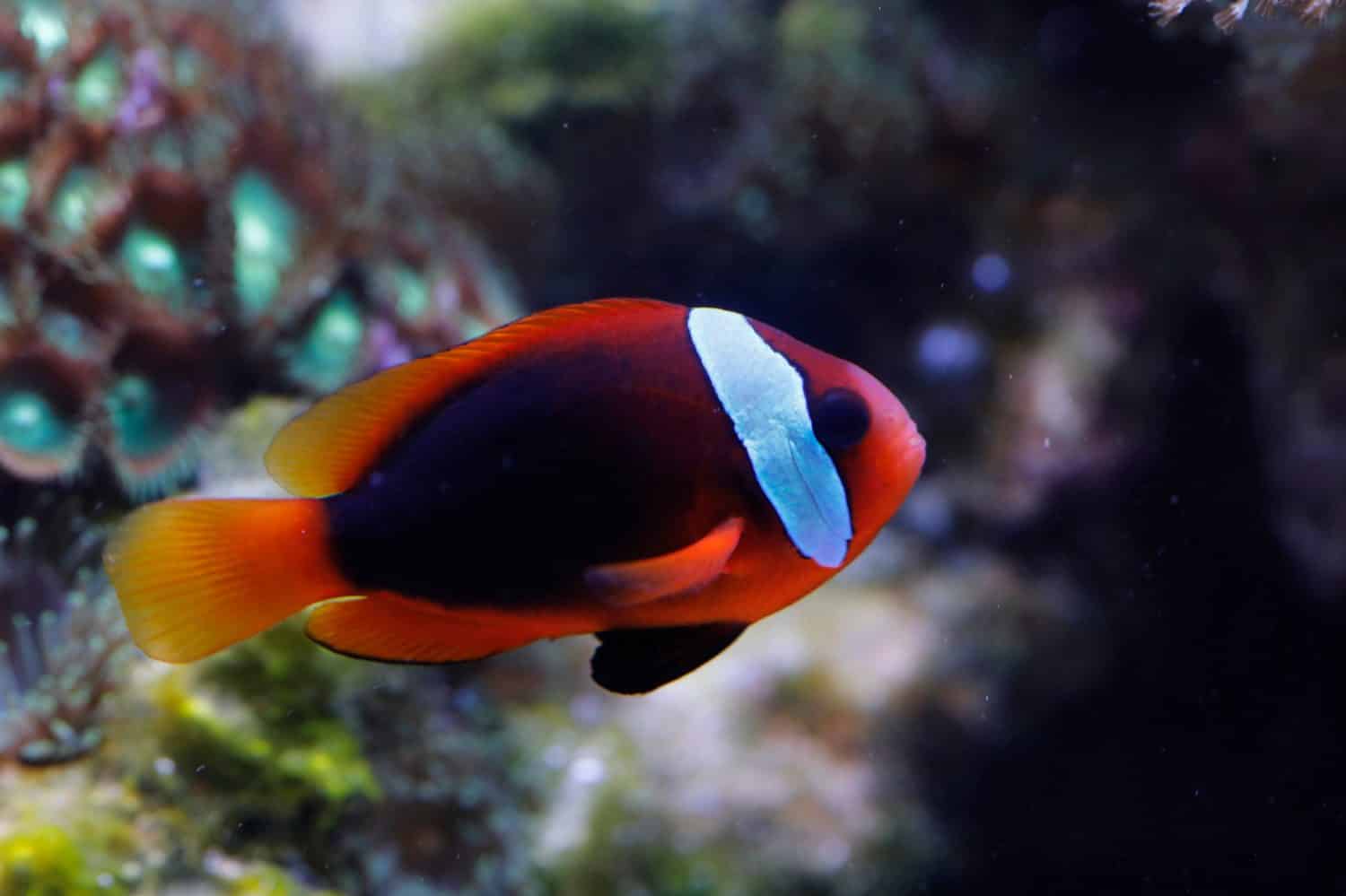
You can find cinnamon
clownfish
in the Great Barrier Reef.
©R. Maximiliane/Shutterstock.com
The cinnamon clownfish (Amphiprion melanopus) is another species that may transition from female to male during their lifetime. Like other species of clownfish, the cinnamon clownfish has a symbiotic relationship with sea anemone.
These fish demonstrate the typical clownfish with a bold white band at the throat. They also sport a bright orange coloration. However, unlike other well-known species of clownfish, the cinnamon clownfish has a dark brown-orange marking. It is for this marking that the fish is named. While a stunning characteristic is the namesake for this little fish, other related species may also share the marking.
Cinnamon clownfish are native to the Western Pacific Ocean. They range from the Great Barrier Reef to Guam.
12. Blue Triggerfish
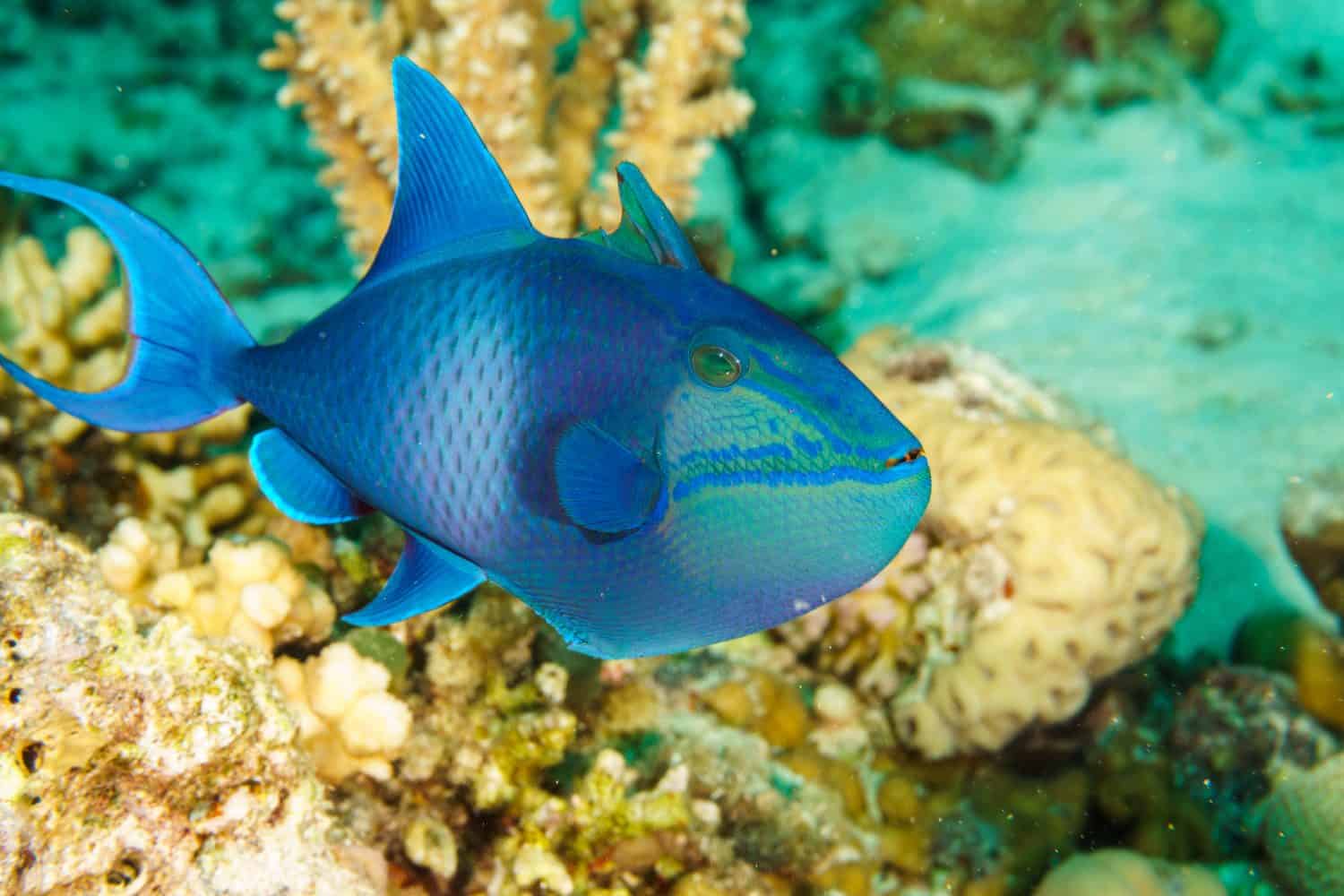
These fish have vibrant purple, blue, and green, along with fierce red teeth!
©Artur_Sarkisyan/Shutterstock.com
When it comes to appearances, there’s no doubt that the blue triggerfish (Odonus niger) is one of the most colorful saltwater fish in the world. These fish are dark purple in color with blue-green markings. It also sports small, red teeth. Because of this, other names for this fish species include redfang triggerfish, redtoothed filefish, and redtoothed triggerfish.
Along with already sporting a colorful appearance, the blue triggerfish actually has the ability to change its color. This means that they can transition from purple to blue. This ability comes as a response to food, water quality, environment, stress, and other factors.
The blue triggerfish is native to the Indo-Pacific Ocean and Red Sea. Like many other species considered to be the most colorful saltwater fish, they can be found in the Great Barrier Reef.
13. Banggai Cardinalfish
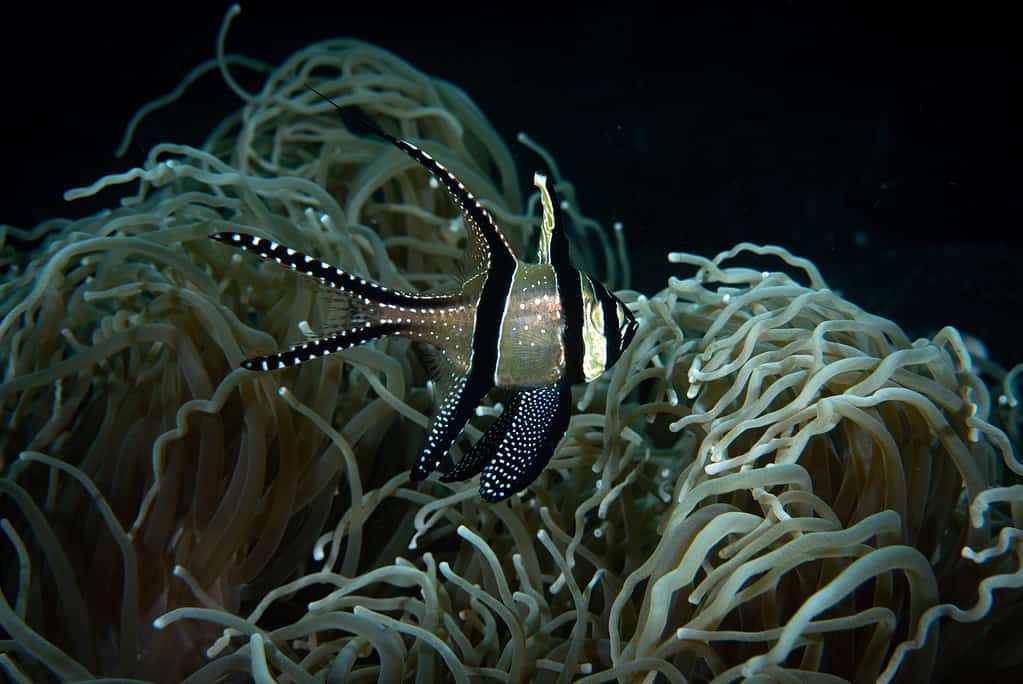
Banggai cardinalfish joined the list of endangered animals as a result of the commercial aquarium trade.
©iStock.com/Francesco Ricciardi
The Banggai cardinalfish (Pterapogon kauderni) looks quite similar to that of an angelfish. However, it is related to another one of the most colorful saltwater fish: the pajama cardinalfish. This fish is a popular marine aquarium resident. However, because captive breeding is difficult, individuals are most often caught in the wild. This has resulted in the species now being listed as endangered.
This species is endemic to a small area. This area is the Banggai Islands of Indonesia, for which they are named. The total area that makes up their habitat is only around 2,124 square miles. They have a yellow-white body with notable dark bands and fins. They also sport white-speckled markings. This dashing appearance is one reason why they are so popular among aquarium enthusiasts.
14. Peppermint Angelfish
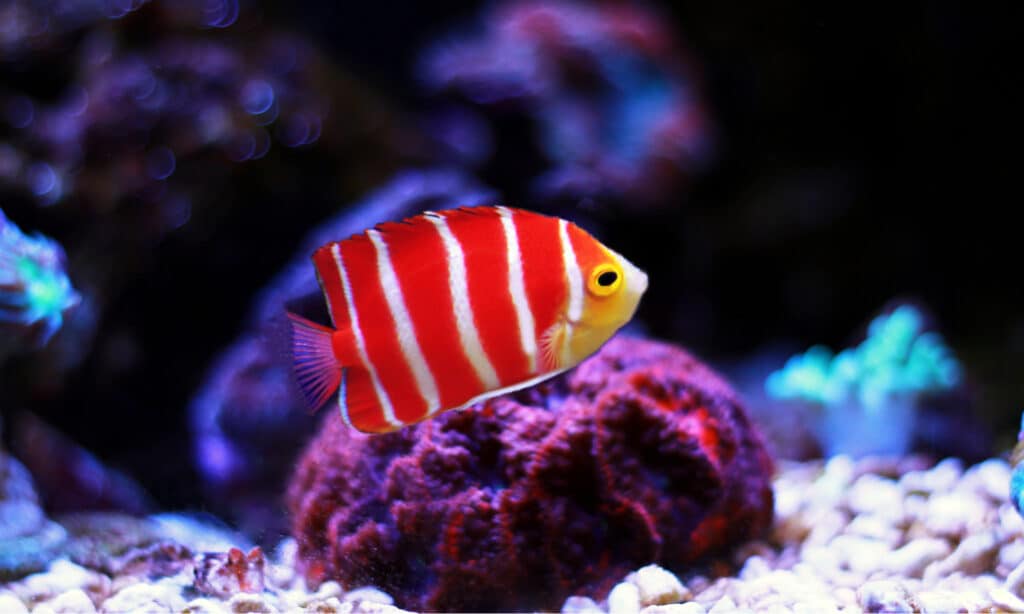
Peppermint angelfish’s unique colors make them look like the candy that they are named for.
©Vojce/Shutterstock.com
The Banggai cardinalfish isn’t the only colorful saltwater fish sporting stripes! The peppermint angelfish (Centropyge boylei) is a small orange-red fish boasting several vertical stripes along its body. Its face and areas on the fins have a more notable yellow coloration. Because of their bright, peppermint-reminiscent appearance, these fish are popular in marine aquariums.
Peppermint angelfish are native to the South Pacific Ocean. This includes the waters off the shore of the Cook Islands. These fish live at depths reaching up to 180 to 394 feet near the outskirts of coral reefs. Most often, they are seen together in pairs or groups. Not much is known about the peppermint angelfish’s diet, but they are likely carnivorous or omnivorous, eating worms.
15. Queen Triggerfish

These fish can change their colors when stressed.
©Sergey Dubrov/Shutterstock.com
The queen triggerfish (Balistes vetula) is native to the Atlantic Ocean. Occasionally, it may be caught as a game fish. In the case of aquariums large in size, the queen triggerfish may also be kept in captivity. In Cuba, the queen triggerfish is known as cochino, most likely after Bahía de Cochinos, or the Bay of Pigs.
With the ability to change colors when subject to stress, there is no doubt that the queen triggerfish is one of the most colorful saltwater fish. The beautiful fish typically sport cool-toned colors, such as blue, green, and purple. Their throat is yellow, and they have light blue lines along their head and fins.
Queen triggerfish often live at depths less than 100 feet, but they have been found as deep as over 900 feet!
16. Rainbow Parrotfish
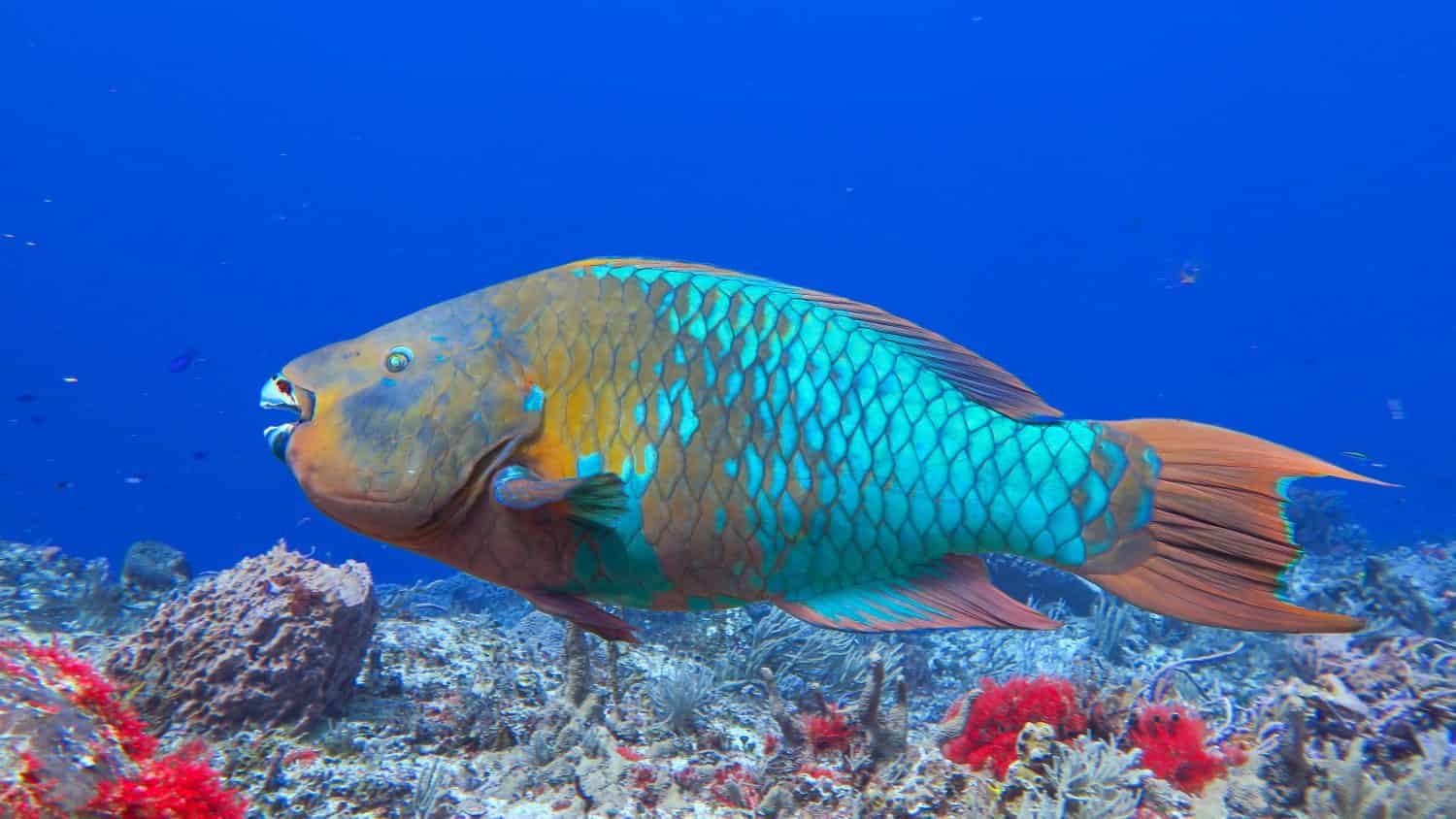
The rainbow parrotfish is the largest Atlantic parrotfish species.
©Denisse Pohls/Shutterstock.com
Rainbow parrotfish (Scarus guacamaia) are some of the largest species of parrotfish in the world. In the Atlantic Ocean, where they are native, they are the largest parrotfish. And, like many others that fall into the parrotfish family, they are one of the most colorful saltwater fish!
The extremities of the rainbow parrotfish, such as its head and fin tips, are brown. However, the rest of the body is a vibrant turquoise-green color. It also has blue-green dental plates, which gives it a striking appearance. They also sport subtle orange markings, such as along their fins.
The rainbow parrotfish is a shallow-water fish. You can find them inhabiting areas such as mangroves and sea grass beds.
17. Six-Line Wrasse
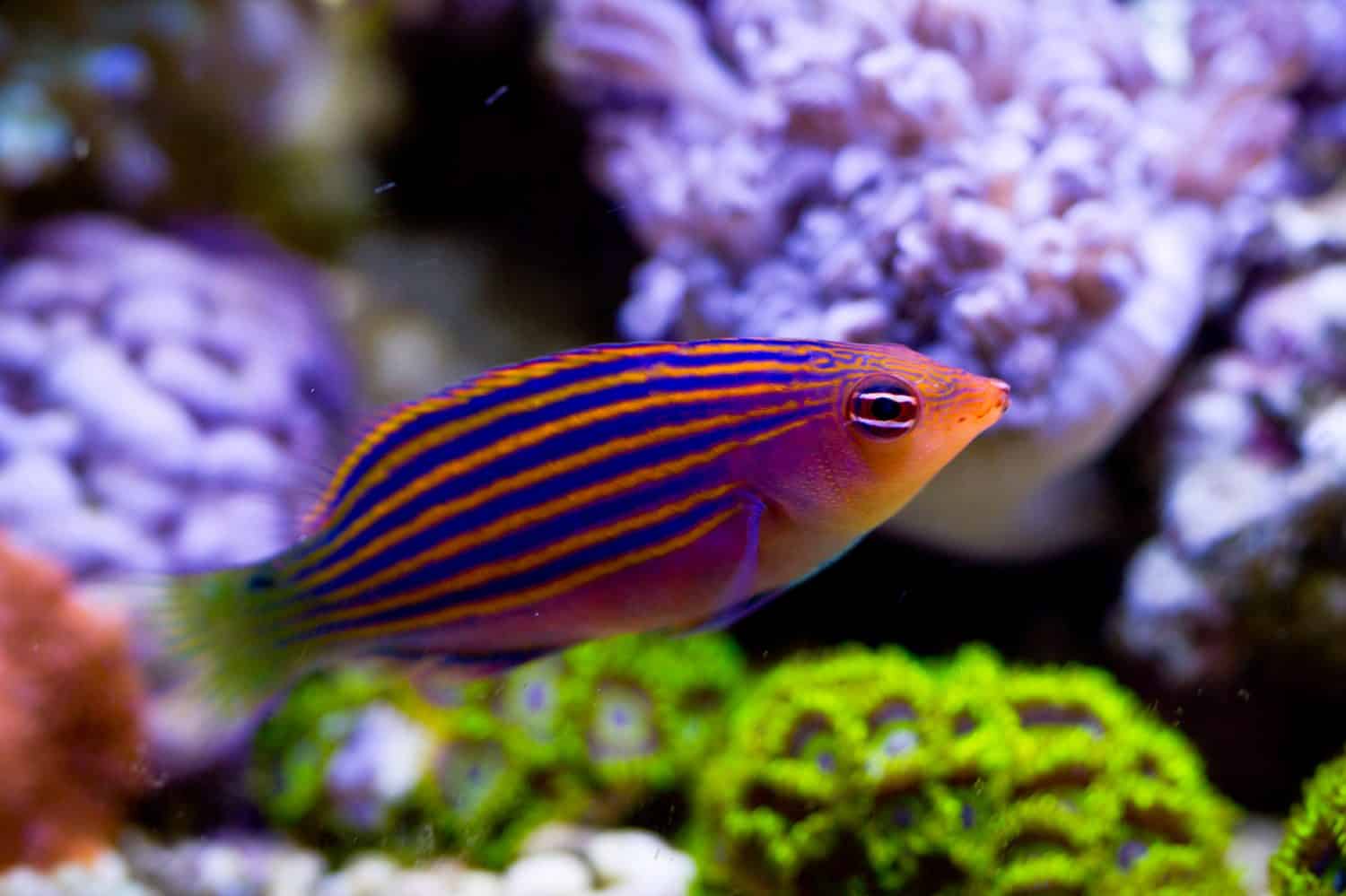
This fish received its name because of its horizontal stripes.
©Artyphoto Stock/Shutterstock.com
The six-line wrasse (Pseudocheilinus hexataenia) is a vibrant species found in the Indo-Pacific Ocean. Overall, they are purple in color. However, they boast a variety of colorful markings. They are named for the six orange stripes that run horizontally along the flank of their body. However, along with these stripes, they also have a blue stripe along their anal fin as well as on their pelvic fin. This species has a striking red eye that stands out among its colorful body.
Six-line wrasse are found along the coast of Africa. Their range can also extend as far as Japan and Australia.
Summary of 17 Most Colorful Saltwater Fish
| Rank | Fish |
|---|---|
| 1 | Flame Angelfish |
| 2 | Queen Angelfish |
| 3 | Mandarin Dragonet |
| 4 | Emperor Angelfish |
| 5 | Bicolor Dottyback |
| 6 | Stoplight Parrotfish |
| 7 | Hogfish |
| 8 | Scrawled Cowfish |
| 9 | Regal Blue Tang |
| 10 | Pajama Cardinalfish |
| 11 | Cinnamon Clownfish |
| 12 | Blue Triggerfish |
| 13 | Banggai Cardinalfish |
| 14 | Peppermint Angelfish |
| 15 | Queen Triggerfish |
| 16 | Rainbow Parrotfish |
| 17 | Six-Line Wrasse |
The photo featured at the top of this post is © Damsea/Shutterstock.com
Thank you for reading! Have some feedback for us? Contact the AZ Animals editorial team.






